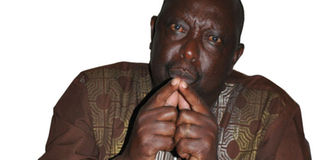We demolished bridges to defend Muteesa

Nathan Kakuba was only 16 years old when he participated in demolishing bridges to stop government forces from accessing Mawogola where Kabaka Muteesa was hiding. Photo by Henry Lubega
When the news of the attack on Lubiri broke out, reaction in Buganda was spontaneous. To many, the immediate thing to do was block the roads by either felling huge trees and putting them across the roads, or demolishing the bridges that stood over rivers.
Through this they were able to affect communication. Nathan Kakuba was a 16-year-old boy in Mawogoola and he was involved in demolishing the bridges in the area to stop government soldiers from accessing their area.
Growing up in Mawogoola as a Muhima, it was a bit tricky to blend in well with the rest because of our pastoral culture.
We never used to wear trousers as we roamed around with our cows. It was not until a new Saaza chief called Mzee Kitayimbwa came that things started to change. He ordered us to put on trousers or else we would not be allowed in the market on the market days.
Due to his mobilisation skills, he succeeded in changing some aspects of our lives and those of the rest of the people by developing them. People of Mawogoola believed in his leadership style so much so that whenever he mobilised them for any activity they turned up in big numbers without question.
Civil disobedience
When the Saaza chief received the news of the attack on Lubiri and the fleeing of Kabaka Muteesa, he turned to his people to defend their area. It was around 11am. I was 16-years-old and I was at Ndaiga market that day when we saw the county chief’s car coming.
As usual we converged towards the car to hear what the chief had to say. He told us what had happened to the Kabaka, and told us to break all the bridges over the streams and rivers surrounding Mawogoola.
The Saaza chief left to go to mobilise in other areas. At Matete, people had already become rowdy saying they are ready to defend their territory from government soldiers. Armed with all the tools they could master, they started demolishing the roads.
I jumped on a bicycle and followed the orders. I rode to Bisanje which was the nearest from where I was. There, I found other people had already started on the work and joined in. Using a pick axe which I got from one of the locals, I played my part. Within no time, the culverts were gone and what had been a road was no more.
The search for the Kabaka
The breaking of bridges was meant to deter government soldiers from coming to our territories fearing they would wreak havoc. However, after that, people desired to know the fate of the Kabaka.
It was later announced on Radio Uganda that whoever knew where the Kabaka was hiding was going to receive a Shs250,000 reward. We didn’t know that by that time the Kabaka was already in Mawoogola. When it was later discovered that the Saaza chief had been hiding him and did not give him up, he won himself praises and admirers.
Soon after the news that Kitayimbwa was hiding the Kabaka and helping him to flee started doing the rounds, it suddenly emerged that he had been arrested for having hidden a fugitive. This was a big blow to the locals. Not only were the Baganda affected, but even the Bahima. The years he was away in prison, life in Mawogola was never the same. His return to Mawogoola, this time not as a chief, was a time for celebration.
But the day we united as one people to break the bridges and block all the roads, was a day to remember. In places where there were no bridges to be broken, huge trees were cut and put across the roads to make them impassable or trenches dug across them.
Kitayimbwa the saaza chief
Born in 1935, to the Kooki royal family, Kitayimbwa started his education at Kasozi Primary School and completed his Junior Three at Namilyango College in 1952.
Later that year, he went on to join Makerere College to study librarianship. However, in 1953 when the Kabaka of Buganda was exiled by then governor Andrew Cohen, Kitayimbwa joined other disgruntled Baganda students in a strike.
They destroyed property in the library, including books. As a result, he was among those expelled from the college and that was the end of his education. “After being expelled from school, I went out looking for jobs. Mengo employed me in 1954 as an accountant in the Sabagabo Makindye County where I also doubled as a court interpreter. When the king returned in 1955, I was transferred to Mengo as an accountant in the justice department in the Mengo government.
I was there until 1960 when the king transferred me to Buyaga County, one of the lost counties that later led to the crisis of 1966. After independence, I was promoted to saza chief and transferred to Mawogola, where I was until 1966.” “During my stay in Buyaga, a strong bond between me and Muteesa developed and I became one of his closest allies.”




